
Posts Tagged: Vernard Lewis
A Celebration of ESA Award Winners
Tuesday, Nov. 2 will be a special day of celebration at the annual Entomological Society of America (ESA) meeting, being held in the Colorado Convention Center, Denver. Tuesday is when ESA will honor scores of award winners at its Founders' Memorial Lecture...
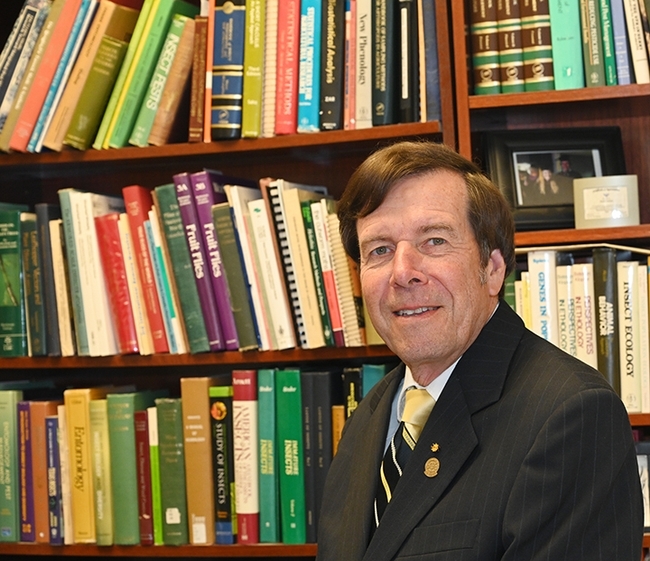
UC Davis distinguished professor Frank Zalom will receive ESA's highest honor, Honorary Member, on Tuesday, Nov. 2. (Photo by Kathy Keatley Garvey)
Bravo to Vernard Lewis and Margaret Collins: Two Legendary Entomologists
Congratulations to emeritus Cooperative Extension specialist Vernard Lewis of UC Berkeley, selected to deliver the Founders' Memorial Lecture at the 2021 annual meeting of the Entomological Society of America (ESA), set Oct. 31-Nov. 3 at the Colorado Convention Center,...
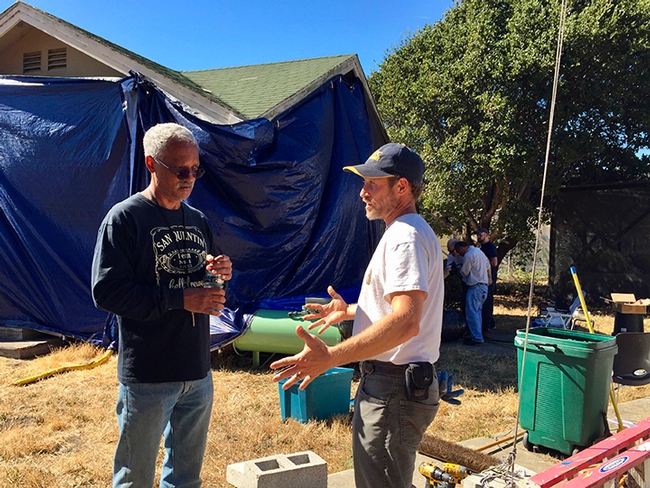
In this image, taken in October 2018, consultant and mentor Vernard Lewis (left), confers with Andrew Sutherland, UC integrated pest management advisor for Bay Area counties, about the Villa Termiti at the UC Berkeley Field Station. Sutherland, who holds a doctorate in entomology from UC Davis, was recently awarded state funding to remodel the Villa for future training of pest management professionals in the state. (UC ANR Photo by Pam Kan-Rice)
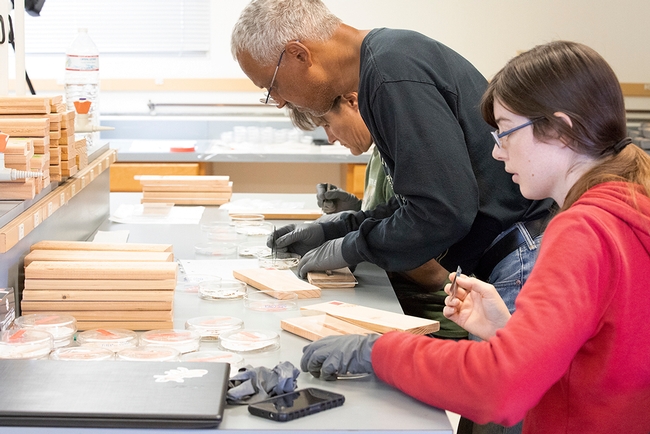
In this 2018 image, entomologist Vernard Lewis shows staff research associates how to insert termites into wood blocks. The project involved placing the wood blocks in a house to see if heat and wintergreen oil will kill termites. In front is Casey Hubble of UC Cooperative Extension, Contra Costa County, and in back is Kathleen Campbell of UC Riverside. (UC ANR Photo by Evett Kilmartin)
Of Termites, Bed Bugs and Cockroaches
We're all going to miss him. The termites, bed bugs and cockroaches--not so much. "Him" is Vernard Lewis, who terminated termites, bugged bed bugs, and controlled cockroaches. As Pamela Kan Rice, assistant director of News and Information Outreach, University of California Division of Agriculture...
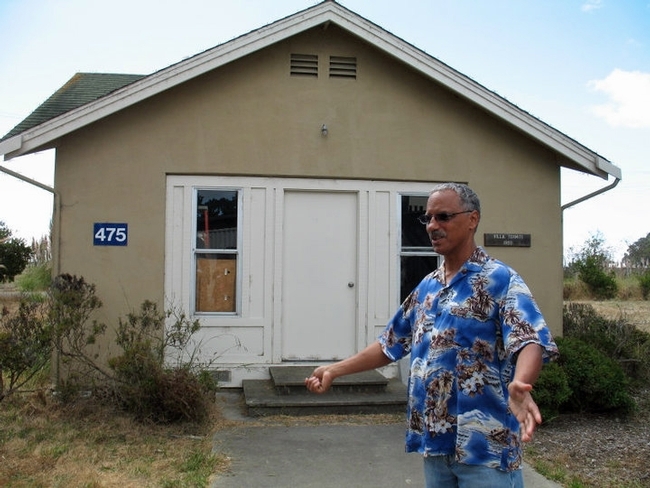
UC ANR urban entomologist Vernard Lewis stands by his Villa Termiti, built just for termite research. (UC ANR Photo)
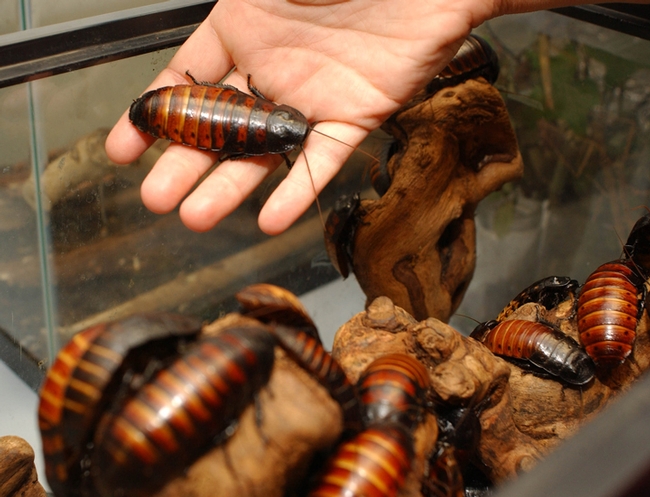
Madagascar hissing cockroaches at the Bohart Museum of Entomology, UC Davis. (Photo by Kathy Keatley Garvey)
Bedbugs prove difficult to detect
UC scientists combat resurgence of bedbug in behavioral studies and monitor trials
Bedbugs are showing up more frequently in California and around the world, and new UC research shows that current methods for detecting the blood-sucking pests aren’t very reliable.
Detecting bedbugs is key to controlling them so a UC study tested three commercial monitors. At best, the monitors containing attractants captured 10 percent of the bedbugs, wrote UC scientists from UC Cooperative Extension, UC Berkeley and UC Riverside in the July–September 2013 issue of California Agriculture, UC's peer-reviewed journal of agricultural, natural and human resources.
As bedbugs become more prevalent, the researchers call for improving monitors as well as developing new methods to lure the insects more effectively.
“If we could put out bait and the bedbugs find it and die, wouldn’t that be great?” said Vernard Lewis, UC Cooperative Extension specialist in the Department of Environmental Science, Policy and Management at UC Berkeley and lead author of the article. Lewis is testing attractants for bedbugs and observing their behavior.
In Villa Termiti, a room built for studying insects, Lewis set up an experiment to see how far the bedbugs moved in a 24-hour period. He found that the bedbugs moved around to a bed, rug or low table, but most stayed close to the cardboard on which they were released in the middle of the floor. The monitors containing attractants captured up to 10 percent of the bedbugs, twice as many as the monitors that didn’t contain attractants, but not a statistically significant difference.
Lewis and his colleagues are studying new ways of detecting bedbugs and exterminating them.
Effective detection to determine the effectiveness of treatments made to eliminate bedbug infestations would be helpful. “When a property is treated and bedbugs reappear, at this point, we can’t tell whether the bedbugs survived the treatment or they are moving in from next door,” Lewis said.
The Lewis Lab is also exploring new methods of bedbug control that minimize the use of pesticides.
Co-author Dong-Hwan Choe, UC Cooperative Extension specialist in the Department of Entomology at UC Riverside, is currently studying essential oils from plants such as clove and wintergreen to see if they can be used as alternatives to synthetic insecticides.

Andrew Sutherland, UC Cooperative Extension advisor for the San Francisco Bay Area, has been meeting with pest control professionals to share the latest bedbug research results and integrated pest management approaches to minimize the amounts of pesticides used.
Sutherland also has begun training UC Master Gardener volunteers to answer questions about bedbugs and to share information about integrated pest management to control insects in the home.
“Master Gardeners in urban counties increasingly get requests regarding household pests,” said Sutherland. “UC ANR is interested in providing education and outreach on this topic because urban pest management significantly impacts water quality and other environmental resources. I have designed a 'Household Pests' unit used in 'Advanced IPM Training' for Master Gardeners.’”
“Master Gardeners will be able to help residents identify bedbug specimens and direct the general public to our Pest Note at http://www.ipm.ucdavis.edu/PMG/PESTNOTES/pn7454.html,” he said.
“Many clients think they may have bedbugs, but actually have recovered specimens of other insects,” Sutherland said. “In those cases we are able to prevent unnecessary and sometimes dangerous pesticide applications. When bed bugs are identified, our message is always to contact a professional pest control operator.”

The exact causes of the bedbug resurgence are not known, but increased international travel among people, pesticide resistance among bedbugs, the ease with which bedbugs can spread, and reduced indoor use of residual insecticides may be contributing factors.
The bedbug article in the July–September 2013 issue of California Agriculture can be downloaded at http://californiaagriculture.ucanr.edu.
Invasive paper wasp responsible for increasing yellow jacket complaints

"The European paper wasp, which is about the same size (as the yellow jacket) but more slender, has built up to enormous numbers in some communities," said Lynn Kimsey, professor in the Department of Entomology at UC Davis. "They have been making their way out of the Sacramento area for the past 20 years."
Kimsey said the wasps have moved outward from Sacramento along river beds and water ways into the Sierra Nevada and along the delta toward San Francisco. In August, 345 wasp nests were removed in South Lake Tahoe.
European paper wasps dine on caterpillars, aphids and honeybees, but switch to mostly carbohydrates in the late summer for energy, said Andrew Sutherland, UC Cooperative Extension advisor in the Bay Area.
Vernard Lewis, UCCE specialist in the Department of Environmental Science, Policy and Management at UC Berkeley, also contributed to the story.
"Where I normally eat my lunch is one of the biggest yellow jacket nests I've seen in years," Lewis said. "It's not just here. I'm getting reports from the Berkeley campus and from Richmond, Antioch and Rodeo. Something is up. It's not just yellow jackets. It's other pests, too, like cockroaches. It's the most I've seen in at least 10 or 15 years."
Fimrite added a link in his article to the UC Statewide IPM Program Pest Note on Yellowjackets and other social wasps.

Yellow jackets, like the one above, are often confused with European paper wasps. (Photo: Wikimedia Commons)
